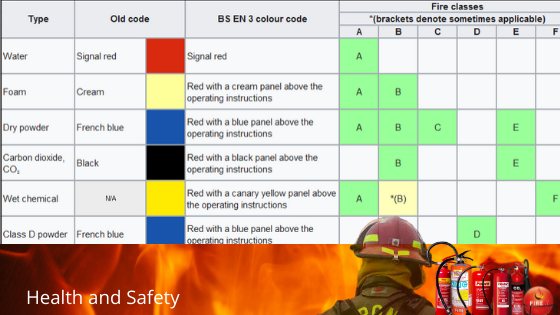Understanding the Workplace Fire and Types of Fire Extinguishers | Health and Safety
The very first step in selecting a proper fire
extinguishers for your home, car or workplace, here we will discuss some common
fire extinguishers, types and what kind of fires they're best suited for.
Before we talk about the types of fire and fire extinguishers though it's
important that you understand how fire actually works. Essentially there are
three main elements that must be present for a fire to come in existence, and
these elements include oxygen to sustain combustion, heat to raise the material
to its ignition temperature, and fuel to support the combustion. When these elements
combine, it creates a chemical reaction which can cause fire, in order to
extinguish any fire, you must remove at least one of these four elements as we
go over the different types of fire extinguishers you will see and how they
each work differently based on the type of fire you're fighting.
Types of Fire Extinguisher and their uses-
Water-Fire Extinguisher and Water with additive Fire extinguishers
are all color-coded Red on the extinguisher description panel. Basic
Instructions on how to operate them are printed on the canister. You should
only use them on flammable solids like wood, paper, textiles, and furnishings.
It can be very dangerous to use them on other types of fire.
Carbon Dioxide or CO2 Fire Extinguishers are
color-coded black on the extinguisher description panel and operating
instructions can be found on the canister. Although Carbon dioxide
extinguishers are primarily for use on flammable liquid fires like petrol, oils
and petroleum-based spirits, we also recommend them for fires in electrical and
electronic equipment as the CO2 gas won’t damage your computer or gadgetry. As
the gas discharge is extremely cold avoid handling the special discharge horn
when using.
Foam Fire Extinguishers are color-coded cream on
the identification panel and again carry basic operating instructions. Larger sizes
normally have an extension hose and low-pressure nozzle. They are intended for
use on flammable liquids like petrol, oils and solvents. As they are water-based they also extinguish flammable solids like wood, paper and textiles.
Dry Powder (DCP) Fire Extinguisher are color-coded
blue and are available in a wide choice of sizes and are very versatile. You
can use them on fires involving flammable solids, flammable liquids, and also flammable
gases such as propane and butane. They also work on fires caused by electrical equipment
but unlike CO2 the powder sets under heat so can leave a sticky residue.
Wet Chemical Fire Extinguisher is color-coded yellow on the identification panel. They contain a special
chemical formulation that reacts with cooking fat and cooking oil fires to
extinguish the fire so are a must for the commercial kitchen. You can now buy
special foam formulations that are effective on cooking fat fires in smaller
canisters for home use.
Ball Fire Extinguisher is a new type of A, B & C fire extinguisher comes in a shape of ball, the main function of ball fire is very simple, just through the ball fire in the middle of fire, the ball fire self-detonates and explodes within 3 to 5 second and spread non-toxic chemical to extinguish the fire.
P.A.S.S Method for using a fire extinguisher-
Every company is going to have someone in charge
of checking these visually on a monthly basis every year, you’ll have them sent
the way to be checked by the professionals but the monthly checks are pretty
simple. Let’s make sure that they're charged, let’s make sure all the parts are
in place that the hose is in good condition, they’re mounted in the right place.
It's easy to lose track of one of these things if they get used, make sure it
gets put back, gets recharged because you never know when you're going to, need
to use one if you happen upon a fire that is small enough for you to actually
fight with. One of these smaller fire extinguishers all you have to remember is
the acronym PASS. PASS helps us learn how to use this thing safely and not
forget it when our mind is being preoccupied by the blaze P is for pole we’re
going to pull the pin, the pin is here to make sure that this thing
doesn’t accidentally get discharged it’s really the only thing that's stopping
the two levers from coming together and discharging the unit. When we pull the
pin make sure we're not squeezing together we're just holding on the underside
it should be pretty easy to pull. It should have some sort of at ether on it or
maybe a plastic band. discard both of those things and that’s what we're going
to go ahead and grab this nozzle and move on to our next letter grab this
nozzle we're going to aim at the base of the fire, stay a nice safe
distance away and S is for squeeze when we squeeze this handle will
discharge the unit and the last thing we're going to do is sweep we're
going to sweep at the base of the fire and try to put out the flames from the base of the fire.



.png)
.png)


Comments
Post a Comment